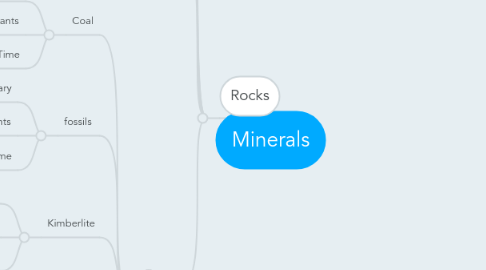
1. Rocks
1.1. Can Contain Minerals
1.2. But Minerals Cant Contain Rocks
1.3. Has No Crystal Shape
1.4. Has No Transparance
1.5. Has No Luster
1.6. Has Many Diffrent Sizes
1.7. Igneous
1.7.1. Igneous rock is formed by cooling magma
1.8. Metamorphic
1.8.1. Metamorphic rocks are formed by high heat and high PSI deep in the earth
1.9. Sedimentary
1.9.1. Sedimentary rocks are formed by organic matter layering on top of each other
1.10. Types
1.10.1. Coal
1.10.1.1. Sedmintary
1.10.1.2. Dead Plants
1.10.1.3. Time
1.10.2. fossils
1.10.2.1. Sedmintary
1.10.2.2. Dead Plants
1.10.2.3. Time
1.10.3. Kimberlite
1.10.3.1. Igneous
1.10.3.2. Magma
1.10.3.3. Volcano
1.10.4. Marble
1.10.4.1. Metamorphic
1.10.4.2. Heat
1.10.4.3. PSI
1.10.5. Obsidian
1.10.5.1. Igneous
1.10.5.2. Volcano
1.10.5.3. Magma
1.10.6. Gneiss
1.10.6.1. Metamorphic
1.10.6.2. PSI
1.10.6.3. Heat
2. Proporties
2.1. Luster
2.1.1. Briliant
2.1.2. Glassy
2.1.3. Dull
2.2. Color
2.2.1. Green
2.2.2. Blue
2.2.3. Ext..
2.3. Transparency
2.3.1. Opaque
2.3.2. Translucent
2.3.3. Tranparent
2.4. Hardness
2.4.1. Mohs Hardness Skale
2.4.1.1. The Hardness Scale
2.4.1.2. Used To Measure Minerals
2.4.1.3. Ranging From 1 to 10
2.4.1.4. 10 Diamond
2.4.1.5. 1 Talc
2.5. Size
2.5.1. Any Size
2.5.2. Varies On Mineral
2.6. Crystal Shape
2.6.1. Cube
2.6.2. Octahedren
2.6.3. Tetrahedren
2.6.4. Rhombahedren
2.6.5. Pyramid
3. Tests
3.1. Acid Test
3.1.1. Take mineral and put drop of acid on it.
3.1.2. See if mineral reacts to acid.
3.1.3. If mineral reacts there will be small bubbles.
3.1.4. If the mineral does not there will be nothing.
3.2. Luster Test
3.2.1. Take the mineral under a light and try to reflect light.
3.2.2. If the mineral reflects light you could now put it into a category witch is in the proporties tab.
3.3. Transparency Test
3.3.1. Set the mineral on a sheet of lined paper.
3.3.2. Look and see if you can see through the mineral.
3.3.3. If you can then you can put it into a catagory
3.4. Color Test
3.4.1. Observe what color the minerals are.
3.5. Streak Test
3.5.1. See if the mineral leaves a streak on a piece of metal
3.6. Mass Test
3.6.1. Put the mineral on a mass measuring tool
3.7. Volume Test
3.7.1. Put the mineral in a measured cylinder with water.
3.7.2. Then set the mineral in and see how much the water rises.
3.8. Hardness Test
3.8.1. Take the mineral and scratch copper
3.8.2. If it left a scratch then scratch glass
3.8.3. If it left a scratch on glass then it is harder than 5.5
4. Extra Facts
4.1. 4 Things to be a mineral
4.1.1. Has to be solid
4.1.2. Has to be found on earth
4.1.3. Has to have crystal structure
4.1.4. Has to be non living
4.2. Geologists
4.2.1. Geologists are people who study rocks and minerals.
4.2.2. They usually study geology.
